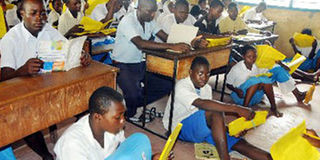We need more classrooms and not just teachers

Pupils in a classroom. From the data available in the Basic Education Statistical Booklet (2014), it is clear that we have enough teachers. What we are lacking are classrooms in which to teach. PHOTO | FILE
What you need to know:
- The deputy principal who was taking me around mentioned that the school is registered by the ministry of Education as a seven-stream institution but they only have six classrooms per form. In total they have 24 classrooms where all the 1,300 pupils learn.
- Luckily, this school received a grant from the government to build an additional eight classrooms and this should ease the pressure. They will bring down the population per class to about 40 pupils.
ABOUT 20 YEARS ago when I was a university lecturer, we encountered an interesting problem at our department. Because of large numbers of students, our copy typist (this was long before computers invaded the Kenyan office space!) was overwhelmed by the workload — typing students’ handouts, test papers and the like.
So our head of department put in a request for one more typist and a strange thing happened: the administration posted the required person but did not supply an additional typewriter! Of course the speed of work did not increase. In fact, it deteriorated as the two typists now spent a lot of time talking.
I remembered this story because of the protests I received from several teachers after they read my piece last week. One of them put it this way: “Are those figures you gave from Kenya or another country? Come to my school and you will see that we handle 50 to 60 students per class. I have never taught a class of less than 30 and I am about to retire. Please verify your figures before you publish.”
MORE CLASSES PLEASE
I agree with this teacher about class populations. In the school where I am a member of the board, we have about 750 students and 39 teachers. The P/T ratio is about 20. Yet if you go to the classrooms, you will find an average of 45 pupils. So, our teachers are overloaded.
I visited one of the national high schools last week and the story I was told provides the answer. The school has 1,300 students and about 70 teachers. When you do the math, the P/T ratio comes to a very admirable 18.6. But when you go to the classroom, you find about 50 to 60 pupils in each.
The deputy principal who was taking me around mentioned that the school is registered by the ministry of Education as a seven-stream institution but they only have six classrooms per form. In total they have 24 classrooms where all the 1,300 pupils learn.
Luckily, this school received a grant from the government to build an additional eight classrooms and this should ease the pressure. They will bring down the population per class to about 40 pupils.
But, unfortunately, it is very likely that some bright fellow at Jogoo House will argue that the school has an additional two streams (8 classrooms) and raise the registration status from 7 to 9 streams! Such a move will take the school back to square one!
From the data available in the Basic Education Statistical Booklet (2014), it is clear that we have enough teachers. What we are lacking are classrooms in which to teach. It is similar to the university getting an extra typist but not a typewriter.
In short, we must build more classrooms urgently. Regrettably, the authors of the Basic Education Statistical Booklet did not recognise this as a problem; it is not mentioned in their list of recommendations.




